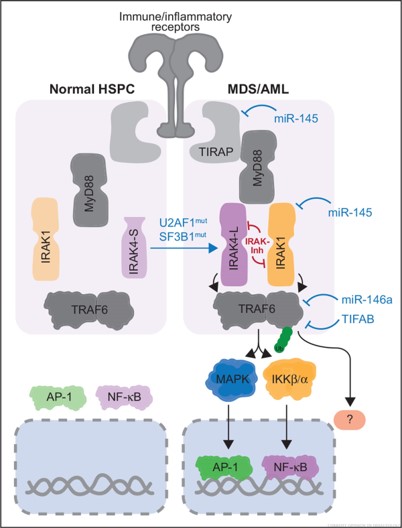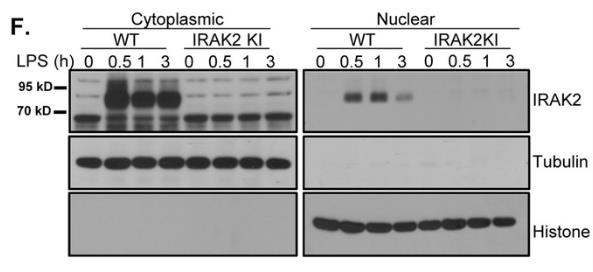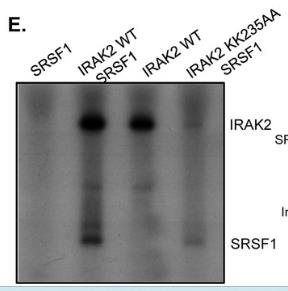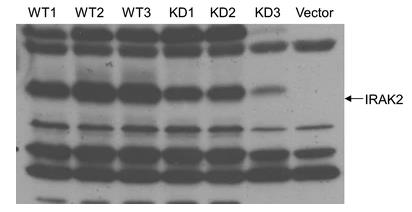IRAK2
-
Official Full Name
interleukin-1 receptor-associated kinase 2 -
Overview
Interleukin-1 (IL-1) receptor-associated kinase (IRAK) is a serine/threonine-specific kinase that can be coprecipitated in an IL-1-inducible manner with the IL-1 receptor. The mammalian family of IRAK molecules contains four members (IRAK1, IRAK2, IRAK3/I -
Synonyms
IRAK2;interleukin-1 receptor-associated kinase 2;interleukin-1 receptor-associated kinase-like 2;interleukin-1 receptor associated kinase-2;IRAK-2;MGC150550
Recombinant Proteins
- Human
- Chicken
- Rat
- Mouse
- E.coli
- Sf9 Cells
- Mammalian Cells
- Insect Cells
- HEK293
- Wheat Germ
- In Vitro Cell Free System
- His
- GST
- Non
- Avi
- Fc
| Cat.# | Product name | Source (Host) | Species | Tag | Protein Length | Price |
|---|---|---|---|---|---|---|
| IRAK2-2753H | Recombinant Human IRAK2 protein, His-tagged | E.coli | Human | His | 14-251 aa | |
| IRAK2-1417H |
Active Recombinant Human IRAK2, GST-tagged
|
Sf9 Cells | Human | GST | Full length |
|
| IRAK2-2317C | Recombinant Chicken IRAK2 | Mammalian Cells | Chicken | His |
|
|
| IRAK2-27503TH | Recombinant Human IRAK2 | Insect Cells | Human | Non | 625 amino acids |
|
| IRAK2-3094R | Recombinant Rat IRAK2 Protein | Mammalian Cells | Rat | His |
|
|
| IRAK2-332H | Recombinant Human IRAK2, GST-tagged, Active | Sf9 Cells | Human | GST |
|
|
| IRAK2-7069H | Recombinant Human IRAK2 protein, His-tagged | E.coli | Human | His | Val235~Ser521 |
|
| Irak2-7070M | Recombinant Mouse Irak2 protein, His-tagged | E.coli | Mouse | His | Asp209~Glu458 |
|
| Irak2-7071R | Recombinant Rat Irak2 protein, His-tagged | E.coli | Rat | His | Asp211~His458 |
|
| IRAK2-8293M | Recombinant Mouse IRAK2 Protein | Mammalian Cells | Mouse | His |
|
|
| IRAK2-5171HCL | Recombinant Human IRAK2 293 Cell Lysate | HEK293 | Human | Non |
|
|
| IRAK2-270H | Recombinant Human IRAK2 protein, His-tagged | E.coli | Human | His | 381-490 aa |
|
| IRAK2-2750R | Recombinant Rat IRAK2 Protein, His (Fc)-Avi-tagged | HEK293 | Rat | Avi&Fc&His |
|
|
| IRAK2-2750R-B | Recombinant Rat IRAK2 Protein Pre-coupled Magnetic Beads | HEK293 | Rat |
|
||
| IRAK2-2997H | Recombinant Human IRAK2 Protein (Val235-Ser521), His tagged | E.coli | Human | His | Val235-Ser521 |
|
| IRAK2-301417H | Recombinant Human IRAK2 protein, GST-tagged | E.coli | Human | GST | Asp14-Glu251 |
|
| IRAK2-4596M | Recombinant Mouse IRAK2 Protein, His (Fc)-Avi-tagged | HEK293 | Mouse | Avi&Fc&His |
|
|
| IRAK2-4596M-B | Recombinant Mouse IRAK2 Protein Pre-coupled Magnetic Beads | HEK293 | Mouse |
|
||
| IRAK2-5053H | Recombinant Human IRAK2 Protein, GST-tagged | Wheat Germ | Human | GST |
|
|
| IRAK2-5729HF | Recombinant Full Length Human IRAK2 Protein, GST-tagged | In Vitro Cell Free System | Human | GST | Full L. 590 amino acids |
|
| IRAK2-7653H | Recombinant Human IRAK2 protein, His-tagged | E.coli | Human | His | 1-625a.a. |
|
Background
What is IRAK2 protein?
IRAK2 gene (interleukin 1 receptor associated kinase 2) is a protein coding gene which situated on the short arm of chromosome 3 at locus 3p25. IRAK2 is a serine/threonine kinase that plays a key role in a variety of cell signaling pathways, especially in immune responses. IRAK2 binds to the IL-1 receptor (IL1R) and is involved in the activation of NF-κB in response to IL-1 stimulation, thereby regulating inflammation and cell survival. It is also involved in other immune-related signaling including TLR (Toll-like receptor) signaling pathways. Abnormal functioning of IRAK2 has been linked to a variety of diseases, including autoimmune diseases and certain cancers. The IRAK2 protein is consisted of 625 amino acids and IRAK2 molecular weight is approximately 69.4 kDa.
What is the function of IRAK2 protein?
IRAK2 is a serine/threonine kinase that plays a pivotal role in the innate immune response. It is involved in the signaling pathways of several receptors, including the interleukin-1 receptor (IL-1R) and Toll-like receptors (TLRs). Upon stimulation by IL-1 or other ligands, IRAK2 becomes associated with these receptors and initiates a signaling cascade that leads to the activation of transcription factors such as nuclear factor kappa B (NF-κB). This activation results in the upregulation of genes involved in inflammation, immune cell activation, and cell survival. Consequently, IRAK2 is crucial for the proper immune response to infection and injury, and its dysregulation can contribute to inflammatory diseases and cancer.
IRAK2 related signaling pathway
IRAK2 plays a key role in multiple signaling pathways, especially in immune responses. It is involved in innate immune responses triggered by Toll-like receptors (TLRs) through activation of signaling pathways dependent on IRAK kinase. IRAK2 is essential for the continued transmission of these signals by associating with TLRs and IL-1 receptors to activate downstream NF-κB and MAPK signaling pathways that regulate inflammatory responses and cell survival. In addition, IRAK2 is involved in the ubiquitination of TRAF6, a key step in the activation of NF-κB. In some TLRs signaling, IRAK2 acts downstream from MyD88 and Mal, but upstream from TRIF.

Fig1. Dysregulation of interleukin 1 receptor-associated kinase-dependent signaling in myeloid malignancies. (Joshua Bennett, 2022)
IRAK2 related diseases
IRAK2 has been implicated in a variety of diseases and plays a key role in regulating inflammatory responses and cell signaling. Abnormal IRAK2 function is associated with the development of digestive diseases such as inflammatory bowel disease, alcoholic liver disease, and colorectal tumors. In addition, IRAK2 is also implicated in the development of diabetic cardiomyopathy, in which it may play a role by affecting mitochondrial function and cell signaling pathways. In the field of oncology, the expression level of IRAK2 is positively correlated with the occurrence and development of tumors, and its activation can promote the growth and invasion of tumor cells, while its inactivation may inhibit the proliferation of tumor cells.
Bioapplications of IRAK2
As an important signaling molecule, IRAK2 is involved in signaling pathways mediated by Toll-like receptors (TLRs) and members of the IL-1 receptor family, influencing inflammatory responses and cell survival. As a result, IRAK2 has become a therapeutic target, especially in the development of drugs for autoimmune diseases such as rheumatoid arthritis (RA), systemic lupus erythematosus (SLE), inflammatory bowel disease (IBD), and more. For example, inhibitors of IRAK2 may help reduce inflammatory processes in these diseases. In addition, functional abnormalities of IRAK2 are closely related to the occurrence and development of tumors, making it a potential target for cancer therapy. Drug development targeting IRAK2 could provide new therapeutic strategies for treating these diseases.
Case Study
Case Study 1: Hao Zhou, 2017
This study identified a novel pathway whereby the activation of LPS/TLR4 promotes nuclear localization of IRAK2 to promote nuclear output and translation of a specific subset of inflammatory associated mRNA in mouse macrophages. Kinase activity of IRAK2 is required for LPS-induced RANBP2-mediated ubiquitination of IRAK2 and its subsequent nuclear translocation. Array analysis showed that mRNA dependent on IRAK2 for nuclear output was rich in SRSF1 binding motifs. Nuclear IRAK2 reduces its binding to target mRNA by phosphorylation of SRSF1, which facilitates the loading of the RNA-binding nuclear output adapter ALYREF and the nuclear output receptor Nxf1, thereby promoting mRNA output.

Fig1. Cytoplasmic and nuclear extracts from WT and IRAK2 KI BMDMs treated with LPS.

Fig2. Phosphorylation of SRSF1 by IRAK2 was assessed by in vitro kinase assay using recombinant IRAK2 and SRSF1.
Case Study 2: Yanmei Liu, 2018
To investigate the importance of IRAK2 kinase activity in TLR-mediated signaling pathways, researchers constructed retrovirus vectors carrying the wild-type mouse IRAK2 gene (IRAK2-WT) or its ATP-binding site inactivated mutant (IRAK2-KD). Next, they compared the functional gain and changes in TLR signaling pathway after the introduction of IRAK2-WT vector in IRAK2-gene knockout (IRAK2-KO) macrophages. IRAK2-KO macrophages were infected with a viral vector (107 cfu/mL) containing the recombinant construct. The results showed that IRAK2-KO macrophages overexpressing IRAK2-WT gene showed changes in IRAK2 expression under LPS induction, while the IRAK2-KD construct did not show such changes under LPS stimulation, and its IRAK2 protein stability was significantly reduced.

Fig3. Expression of IRAK2 in phoenix cell line.

Fig4. The role of kinase activity of IRAK2 in TLR4 signaling.
Quality Guarantee
High Purity
.jpg)
Fig1. SDS-PAGE (IRAK2-7069H)
.
.jpg)
Fig2. SDS-PAGE (IRAK2-270H)
Involved Pathway
IRAK2 involved in several pathways and played different roles in them. We selected most pathways IRAK2 participated on our site, such as Apoptosis,Neurotrophin signaling pathway,Tuberculosis, which may be useful for your reference. Also, other proteins which involved in the same pathway with IRAK2 were listed below. Creative BioMart supplied nearly all the proteins listed, you can search them on our site.
| Pathway Name | Pathway Related Protein |
|---|---|
| Tuberculosis | IL6,MYD88,TGFB2,CAMK2A,CASP9,KSR1,IFNA7,FCGR3A,CORO1A,RFXANK |
| Apoptosis | PANK1A,BOK,CASP9,TNFRSFA,PRKAR2B,BADB,AKT2L,TNFRSF10A,NFKBIA,CASP7 |
| Neurotrophin signaling pathway | PTPN11,FOXO3,HRAS,CALML5,MAPK7,KRAS,SORT1,ARHGDIA,SHC3,ZFP110 |
Protein Function
IRAK2 has several biochemical functions, for example, ATP binding,protein binding,protein heterodimerization activity. Some of the functions are cooperated with other proteins, some of the functions could acted by IRAK2 itself. We selected most functions IRAK2 had, and list some proteins which have the same functions with IRAK2. You can find most of the proteins on our site.
| Function | Related Protein |
|---|---|
| ATP binding | GC3,EHD4,ATP6AP1,UBE1Y1,PFKMB,MSH4,SWAP70,P2RY2,EPHB4A,MARK1 |
| protein serine/threonine kinase activity | BMPR1AA,STK35L,STK30,TAF1,MAPK6,PHKG1B,STK39,RPS6KB2,ACVR1L,MAPKAPK5 |
| protein binding | DOCK10,RARB,VBP1,CMTM5,CCDC64B,HDAC1,NONO,ATG7,MAP2K4,BICC1 |
| protein homodimerization activity | NTSR1,DAPK3,EVLA,HNF1B,BAK1,VPS24,MAP3K10,C6orf108,MAOB,ENG |
| protein heterodimerization activity | BCL2,CENPW,ADIPOR2,MLXIPL,AXL,KCNH1,MAPK4,BMP2,TENM2,XBP1 |
Interacting Protein
IRAK2 has direct interactions with proteins and molecules. Those interactions were detected by several methods such as yeast two hybrid, co-IP, pull-down and so on. We selected proteins and molecules interacted with IRAK2 here. Most of them are supplied by our site. Hope this information will be useful for your research of IRAK2.
TRAF6;IRAK1;TIRAP;IRAK3;k7_vaccc;ARAF;STT3A;TARDBP;ZC3H12A
Resources
Related Services
Related Products
References
- Furi, I; Sipos, F; et al. Association of Self-DNA Mediated TLR9-Related Gene, DNA Methyltransferase, and Cytokeratin Protein Expression Alterations in HT29-Cells to DNA Fragment Length and Methylation Status. SCIENTIFIC WORLD JOURNAL :-(2013).
- Rosenbaek, LL; Assentoft, M; et al. Characterization of a novel phosphorylation site in the sodium-chloride cotransporter, NCC. JOURNAL OF PHYSIOLOGY-LONDON 590:6121-6139(2012).
- Ovsyannikova, I; Haralambieva, I; et al. The role of polymorphisms in Toll-like receptors and their associated intracellular signaling genes in measles vaccine immunity. HUMAN GENETICS 130:547-561(2011).


